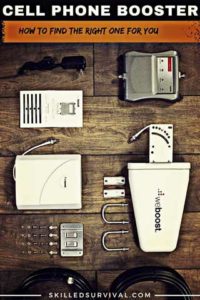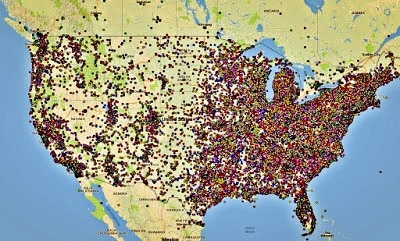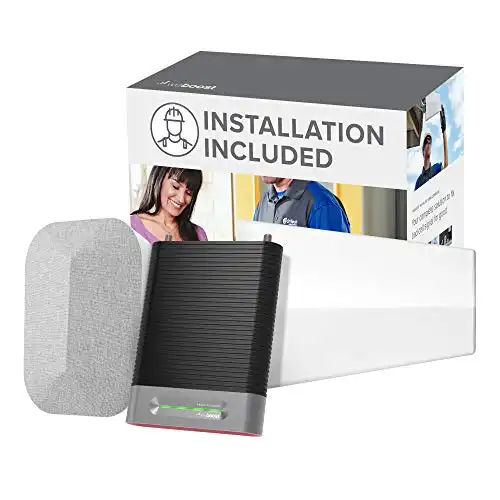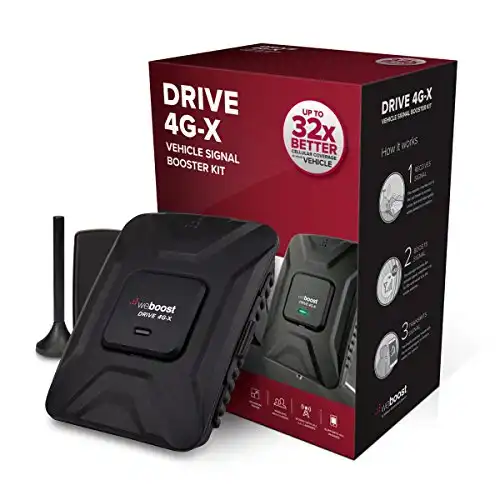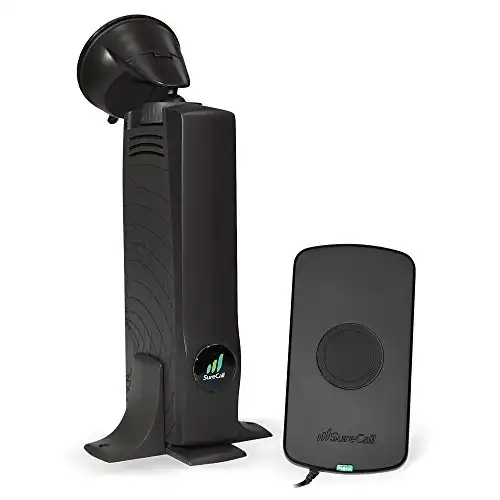Today I’ve got something really important to share…
A Complete Guide To Finding (& Using) A Cell Phone Booster
Because over the last decade, we’re all dependent on cell phones.
- We use them to make calls
- To send text messages
- Play games
- Navigation
- Even check our account balances
So it’s hardly a surprise that a weak (or no) cell signal has become a “modern-day crisis.”
You don’t have to live with this situation…
You just need a cell phone booster, but which one is best for you?
TOPICS IN THIS GUIDE… ↓(click to jump)
- The Insanity Of The ‘No Signal’
- Why Cell Signals Become Weak
- How To Measure A Cell Signal
- Fixing Cell Signal “Dead Zones”
- How Cell Phone Signal Boosters Work
- Best Signal Boosters For Your Home
- Best Phone Boosters For Vehicles
- Finding The Right One For You
- Why You Should Invest In A Booster
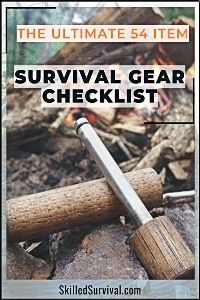
Want a free 54 item survival gear checklist?
Click here to instantly download this Complete Checklist PDF. No purchase necessary.The Insanity Of The ‘No Signal’
The ‘No Signal’ problem is becoming so common it’s made its way into Hollywood lore:
↓ No Signal (and other cellular drama)
It’s become so bad people will perform all sorts of gymnastics tricks to get a tiny bit of signal.
Balancing on tiptoe on the hood of their car or hanging out of a third-story office window to call a friend or get their text message sent.
It’s insane!
From a survival standpoint, cell phones are unreliable for widespread emergency communication.
There are better communication options.
But cell phones are great for individual local emergencies.
The bottom line is:
A weak cell phone signal is a problem you don’t have to live with if you know how to solve it.
Why Cell Signals Become Weak
There are several factors in cellular strength at any given location.
In rural areas, service providers space their cellular antenna towers further apart.
They also upgrade to newer technologies less often due to construction and equipment costs.
Less powerful towers spaced further apart equates to weaker signals.
However, you can still find limited cell coverage in urban areas with many cell towers called “dead zones.”
For example:
My coworker jokes that our office must be lined with lead since everyone misses calls frequently deals with dropped calls, and texts won’t go through.
In a sense, they’re not far from the truth!
The materials used in building construction have a significant influence on strength.
While cellular technology is commonplace today, the buildings we live and work in were designed before cellular reception was developed.
Brick or concrete walls, poured concrete floors, foil-backed insulation materials, and structural steel all reduce cell strength inside buildings.
Even energy-efficient windows and metal window screens filter out some of the signals.
After you add up all these common building features, it’s no wonder you see people standing outside to place a call.
Some locations and some States are worse than others.
↓ Weak Cellular Signal Tips and Tricks
How To Measure A Cell Signal
Now, before spending any time, energy, and dollars on fixing a weak cell signal problem, it’s best to confirm that it’s the signal weakness that’s giving you fits.
There could be any number of other issues causing you trouble, so let’s confirm it’s a weak signal first.
The best way to do this is to measure the cell strength using your phone.
If you want to measure the strength in your area, many smartphones have a “field test mode.”
This mode will give you signal strength readings in decibels instead of bars.
Accessing your phone’s field test mode is different for each device.
So a quick internet search will help you find how to turn on field test mode.
Here’s how to get to “field test mode” with an iPhone.
↓ iPhone – Hidden Settings For Accurate Signal Strength Numbers
Once you’re in “field test mode,” you must understand how to interpret the readings.
The decibel strength is a negative number (though the negative sign is often not displayed).
A more positive number indicates a stronger signal – so a -80dB is much stronger than a -90 dB.
The decibel scale is logarithmic, so a -80dB is 10x the strength of a -90dB!
Once you’ve proven that lack of cell signal strength is your problem, it’s time to start looking at some solutions.
↓ The Truth About Home Cell Phone Signal Boosters
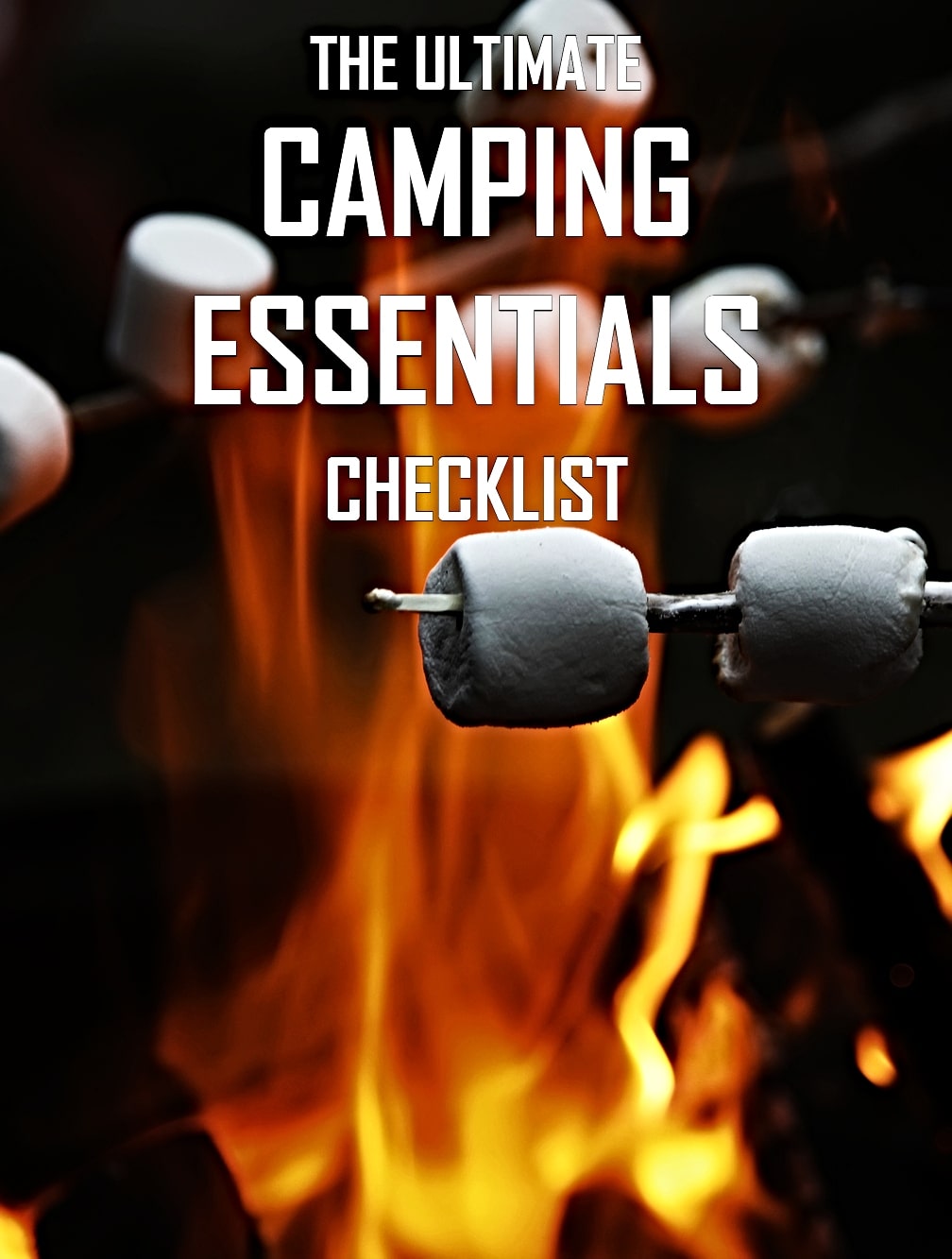
Want a free camping essentials checklist?
Click here to instantly download this Complete Checklist PDF. No purchase necessary.Fixing Cell Signal “Dead Zones”
You likely have zero control over your area’s cell tower signal strength.
And you can’t easily change the construction materials in our homes or offices.
However, there’s one simple fix that can have a dramatic effect on your cell phone’s signal strength.
You can use a cellular “booster” or amplifier.
A cell phone booster increases the local cell signal, but it can’t create one.
So it’s crucial to test the non-boosted signal before spending the time and money to install a cellular booster.
This is where it’s valuable to pull out your phone, put it in Field Test Mode, and check the local cell strength.
If you have a weak signal but can’t maintain a call or send texts, you may be in a situation where a cell signal booster makes sense.
If you have a ZERO signal, a booster won’t help!
You’ll have to look into other resources, like “voice over IP” and other Internet-based solutions.
How A Cell Phone Signal Booster Works
A typical cell phone booster consists of three main parts:
- Outdoor antenna
- Indoor antenna
- Amplifier
Think of it as your own personal cell tower.
One dedicated to getting your signals in and out to the closest cell network tower.
The outdoor antenna is usually installed near a window or on the roof where a cell signal is the strongest.
This is the antenna that communicates directly with the cell tower.
Some antennas are omnidirectional, while some are directional.
Omnidirectional means they receive and send in all directions.
This allows them to communicate with cell towers in more than one location – and from more than one carrier.
Directional means they must be aligned with a nearby cell tower for the best results.
Directional antennas take more time and effort to set up and limit you to a specific tower.
However, they provide a stronger link with a tower, so they work at longer distances.
The indoor antenna is the antenna that communicates with your cellular device.
They are typically optimized to provide even cell strength in all directions.
This means they should be placed near the center of the home or office if possible.
Cellular boosters take weak outside signals, reduce noise and interference, and rebroadcast them inside at a higher strength.
Similarly, it takes your outgoing call, increases the cell strength, and broadcasts it out to the cell tower.

Want a free camping essentials checklist?
Click here to instantly download this Complete Checklist PDF. No purchase necessary.Best Cell Phone Signal Boosters (Home/Office)
There are many cell phone signal boosters for homes on the market at a wide range of prices.
In general, expect to pay more for stronger outdoor antennas.
So the models with high-powered directional antennas will come at a premium.
Recently, we tested the Wilson WeBoost 4G-X cellular booster.
This is Weboost's top-of-the-line model, with a strong directional antenna and claims up to 32dB boosts in signal strength.
It also states it can cover up to 7500 sq ft of building space.
That's good enough for even the biggest homes and many office buildings.
It works with all major providers and can support several different devices at the same time.
To give ours a challenging test, we went out to a friend's farm in the rural mountains.
They’ve had a notoriously poor cellular signal for years. They often don’t have any service in their garage or basement.
To make matters worse, my friend and his wife have separate business cell plans. This means each of them has different dead zones throughout the property.
Setting up the WeBoost 4G-X was straightforward - just a few cables to connect and a power supply to plug into the wall.
We mounted the outdoor cell phone signal antenna on his roof, near his radio antenna and satellite dish. This gave us access to the coaxial cable which we ran alongside his other data cables into the attic. The attic was where the amplifier was located.
From there, we ran a second coaxial cable down through an interior wall to our wall-mounted indoor antenna.
Next, we put his iPhone in Field Test Mode with the power supply plugged into an attic outlet. We then slowly rotated the outdoor antenna to find the orientation with the best signal strength.
Luckily, both networks seemed to have a tower in roughly the same direction. So both networks experienced a huge bump in signal strength inside the house.
While we didn’t get the theoretical 32dB increase, it was at least 20 dB. It provided “3-4 bars” throughout most of the house, even out into the garage and barn.
Check out this excellent overview of the 4G-x Cell Phone Signal Booster.
You’ll be a smarter person after you watch this:
↓ Connect 4G-X Cell phone signal booster for your home
The Wilson model we tested was one of the highly-ranked boosters available online.
HiBoost also has models with similar specifications and positive reviews.
Others, such as Cisco, have carrier-specific “microcell” boosters.
These provide a more streamlined user interface if only one carrier is needed (i.e., all devices are on AT&T).
Best Signal Boosters (Cars/Trucks)
Of course, it’s not only at home and work we run across dead zones.
We all know how quickly a phone call can drop the further you drive away from an urban environment.
Luckily, smaller versions of these home cellular boosters are available for installation in your car, truck, or RV.
This allows you to pull in even the weakest signals on the go.
The components are similar, though the antenna sizes and amplifier power are smaller than home units.
This is due to FCC regulations.
Wilson also recently sent us a test model of their highly-rated WeBoost Drive 4G-X mobile cell phone booster. This mobile booster claims up to a 32dB increase in signal strength. It's designed with a mini-magnet mount outside antenna, a compact amplifier, and an inside antenna.
Like many home units, it also supports multiple devices on multiple networks.
Also, like the home version, the installation of mobile boosters is straightforward. The hardest hard part was routing the cables cleanly so they were out of sight and secure.
The outside antenna is mounted securely with a magnet base on my car. You may have to be more creative with fiberglass truck canopies or convertibles.
The small coaxial cable from the antenna to the amplifier fits easily through the weather gasket of the rear door. It's also tucked neatly into the interior trim panels. This allowed me to route the cable all the way to a small cargo hatch in the rear cargo compartment. This is also where I mounted the amplifier.
I ran an extra 12v outlet to the cargo hatch. Then mounted, the inside antenna on the pillar behind the driver's side door.
This gave me the best boost in signal for the driver. I wish I could have mounted it in a more central location, as I don’t think the passenger side gets as much of a boost.
I already get a strong signal near my house. So I headed out to the coastal mountains to test this mobile cellular technology.
Over the years, I’ve found many trailheads and remote campsites with very little reception. This has often made coordinating trips (and search and rescue activities) more difficult.
While I’ve been on the road the past month or two, I’ve kept the booster turned off until I notice a drop in signal strength.
In most cases, turning on the Drive 4G-X is enough to bring the signal up from a single bar to 3-4 bars on an iPhone.
As long as I wasn't entirely out of signal range, the booster worked as advertised. It turned a weak, unreliable signal into a dependable one.
It's a worthwhile device that I like having in my vehicle.
↓ Reviewing the weBoost Drive 4G X Cell Amp Trucker Antenna
Again, I tested the Wilson WeBoost model. However, other manufacturers have similar devices, such as SureCall.
In the mobile market, it appears that carrier-specific boosters are far more common.
This is likely due to the smaller form factor and lower power ratings of mobile boosters.
This limitation makes optimizing for multiple carriers a challenge.
But, it’s worth noting how often you travel with companions with different carriers.
That’s why the Wilson WeBoost model stands above the rest.
I’m glad to have a multi-carrier booster in my car for its flexibility.
The SureCall FusionTrek booster is certified by the FCC (US) and IC (Canada) for use as a personal cellular booster.
This certification allows it to work on nearly all of the major US carriers (AT&T, Verizon, T-Mobile, and Sprint) and the popular Canadian carriers (Rogers Wireless, Telus Mobility, Bell, and Freedom Mobile).
Installation of the SureCall FusionTrek booster is clean and straightforward, though the bulky antenna in the rear window needs to be mounted securely and out of your field of vision.
While some of the other cell boosters have a smaller antenna unit, they usually have another box of circuitry that has to be mounted under or behind a seat.
In addition, most other cellular boosters require an exterior-mounted antenna, which makes it more complicated to route wiring and find locations for all the components.
The all-in-one antenna design of the SureCall makes it simple to install and easy to transfer to another vehicle if needed.
Once the antenna unit is mounted in the rear window, a single small wire connects to a cell phone cradle that clips to the A/C vent and a 12V power plug.
Again, simple, the non-damaging installation makes it easy to mount the SureCall in nearly any vehicle in minutes, even a rental!
One drawback to the SureCall is that your phone needs to be in the dashboard cradle (or very close to it) to communicate with the cellular booster. This means you’ll need to get much more comfortable with a speakerphone or another hands-free device.
It’s not a deal-breaker for me, but if you’re looking for a booster that allows you to walk around the vehicle, this might not be the best option.
It also means that only one device can take advantage of the signal boost at a time, which might work for your work truck but not for your family camper.
Overall, the SureCall FusionTrek 4G LTE vehicle cellular booster is a good, portable option to extend the range of your cellular device.
It’s easy to manage, simple to install, and works in any vehicle without much hassle.
Dropping your cell phone onto the cradle allows you to make calls, stream music, get driving directions, and check your email, even in remote locations.
↓ SureCall FusionTrek Vehicle Cellular Booster

Want a free camping essentials checklist?
Click here to instantly download this Complete Checklist PDF. No purchase necessary.Best Cell Phone Signal Booster For YOU
At this point, you have enough information to start comparing specific cell phone signal booster models to find the best one for your needs.
Now you need to ask yourself a few questions to hone in on the right one.
So it’s worth keeping a few things in mind by asking the following questions:
Do You Need To Support One Device Or Multiple Devices?
Some cell boosters are dedicated to single devices, while others are set up to work with multiple.
Single-device cell phone boosters tend to cost less, so it’s important to know if you need to set up multiple networks.
Will Those Devices Be On One Carrier Or Multiple Carriers?
If you only have a single carrier in your home or car, you can use a carrier-specific directional antenna (instead of an omnidirectional one).
Otherwise, you’ll need to focus on an omnidirectional option.
Will You Be On The Road Or At Home?
If you’re looking for a better signal on the road or at your favorite campsite, you’re looking for a vehicle cell phone booster option.
If your home has some annoying dead zones, the home & office options are right for you.
How Much Area Do You Need To Cover (i.e., how big is the dead zone)?
The larger the square footage of the cell boost you need, the more it costs.
If your home is 1,500 square feet, then you don’t need to go all the way up to the 5,000 square feet model.
But you may need the larger coverage model if you’re trying to get a signal out to your remote barn.
How Strong Is The Signal Without A Booster?
You can boost a weak signal; a non-existent one cannot.
Use the field test mode on your phone to make sure you can boost before you invest in a unit that cannot fix your cell signal problem.
Why Invest In A Cell Signal Booster
Cell phone signal boosters can work well in many remote locations.
Places that might be off the grid, where signals are faint but still there.
Maybe you have a survival retreat in the woods and want to use your cell phone.
Or maybe you have a bug out vehicle where you want to have the means to communicate while on the move.
So again, cell phones are not the best SHTF communication device (Ham survival radios are better).
But they are still good for more common emergencies and everyday rescue communication efforts.
Plus, dealing with a weak cell signal is a pain in the “you know what.”
So thankfully, you can do something about it – invest in a high-quality cell phone signal booster!
Why Trust Skilled Survival...
Go here now to review a full breakdown of:
- Who We Are
- Our Credentials
- Our Mission
- & Product Recommendations...
Here are a few highlights of our teams credentials & certifications:
- Certified Member of a Mountain Search & Rescue Organization
- Plant Emergency & Safety Leader for a Major Food Manufacturer
- Member of the 10TH Mountain Division Hut Association
- Certifications: Avalanche 1, WFR, CPR
- Official Gear Tester for Numerous Outdoor Gear Companies
- Countless Multiday Backpacking trips into Remote Wilderness
- Bachelor's Degree In Mechanical Engineering
- Bachelor's Degree In Civil Engineering
- Bachelor's Degree In Biomedical Engineering
"It takes 20 years to build a reputation and five minutes to ruin it." - Warren Buffett
We're fully aware that TRUST is NOT something you GET but is EARNED.
And we'll continue to earn YOUR trust through our forthright and honest approach with each new Blog Post, Guide & Product we create...
Jason K.
P.s. Do You Live In A 'Danger Zone' County?
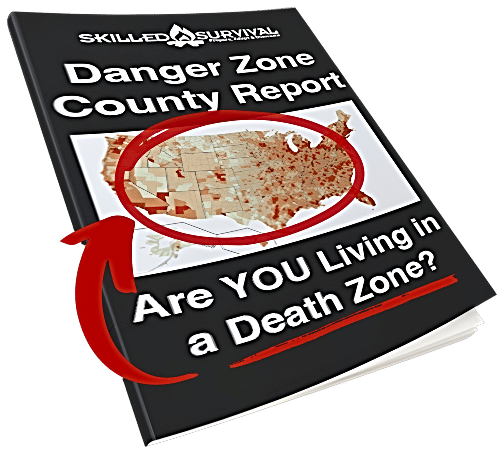
Find out now using my Danger Zone County List & Special Report it’s absolutely FREE.
In minutes you’ll know EXACTLY where you stand and if you should be worried or not..
So click here to get my FREE Danger Zone County List & Report…

Recommended Reading
10 Best Walkie Talkies Picked By A Mountain Rescue Expert
Best walkie-talkies 1. Rockie Talkie 2. Backcountry Access 3. Midland LXT600VP3 4. BaoFeng UV-82 HP 5. Midland GXT1000VP4 6. Motorola RMU2080D
Best Tactical Boots That Can Handle The Most Brutal Terrain
Not all boots are created equal and if you want the best, you have to go tactical. We review the best tactical boots on the market today.
Best Tactical Belts (& Setups) For Extreme Combat
The best tactical belts are innovative, versatile, durable and 100% worth wearing! In this guide, we review the best ones on the market to make your search easy.
Best Folding Saws To Easily Pruning Or Clear Massive Brush
The best folding saws are sharp, durable, compact and 100% worth owning! In this guide, we review the best ones on the market to make your search easy.
Best Headlamps Experts Trust For Hunting, Hiking & Survival
Not all illumination is created equal, some options are great, but many are a waste. I show you the best headlamps and key features you want.
Best Tactical Gloves For The Most Unforgiving Tasks
Not all gloves are created equal. A few are excellent, while many are rubbish. We show you the best tactical gloves and features to look for.
